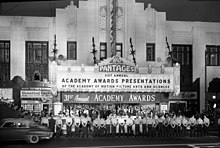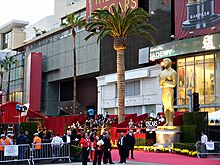Academy Screening Room[edit]
The Academy Screening Room or Academy Digital Screening Room is a secure streaming platform which allows voting members of the Academy to view all eligible films (except, initially, those in the International category) in one place. It was introduced in 2019, for the 2020 Oscars, though DVD screeners and Academy in-person screenings were still provided. For films to be included on the platform, the North American distributor must pay $12,500, including a watermarking fee, and a digital copy of the film to be prepared for streaming by the Academy. The platform can be accessed via Apple TV and Roku players.[72][73] The watermarking process involved several video security firms, creating a forensic watermark and restricting the ability to take screenshots or screen recordings.[74]
In 2021, for the 2022 Oscars, the Academy banned all physical screeners and in-person screenings, restricting official membership viewing to the Academy Screening Room. Films eligible in the Documentary and International categories were made available in different sections of the platform. Distributors can also pay an extra fee to add video featurettes to promote their films on the platform.[75] The in-person screenings were said to be cancelled because of the COVID-19 pandemic.[76] Eligible films do not have to be added to the platform, but the Academy advertises them to voting members when they are.[75]
Awards ceremonies[edit]
Telecast[edit]
The major awards are presented at a live televised ceremony, commonly in late February or early March following the relevant calendar year, and six weeks after the announcement of the nominees. It is the culmination of the film awards season, which usually begins during November or December of the previous year. This is an elaborate extravaganza, with the invited guests walking up the red carpet in the creations of the most prominent fashion designers of the day. Black tie dress is the most common outfit for men, although fashion may dictate not wearing a bow-tie, and musical performers sometimes do not adhere to this (the artists who recorded the nominees for Best Original Song quite often perform those songs live at the awards ceremony, and the fact that they are performing is often used to promote the television broadcast).
The Academy Awards is the world's longest-running awards show televised live from the U.S. to all time zones in North America and worldwide, and gathers billions of viewers elsewhere throughout the world.[77] The Oscars were first televised in 1953 by NBC, which continued to broadcast the event until 1960, when ABC took over, televising the festivities (including the first color broadcast of the event in 1966) through 1970. NBC regained the rights for five years (1971–75), then ABC resumed broadcast duties in 1976 and its current contract with the Academy runs through 2028.[78] The Academy has also produced condensed versions of the ceremony for broadcast in international markets (especially those outside of the Americas) in more desirable local timeslots. The ceremony was broadcast live internationally for the first time via satellite since 1970, but only two South American countries, Chile and Brazil, purchased the rights to air the broadcast. By that time, the television rights to the Academy Awards had been sold in 50 countries. A decade later, the rights were already being sold to 60 countries, and by 1984, the TV rights to the Awards were licensed in 76 countries.
The ceremonies were moved up from late March/early April to late February, since 2004, to help disrupt and shorten the intense lobbying and ad campaigns associated with Oscar season in the film industry. Another reason was because of the growing TV ratings success coinciding with the NCAA basketball tournament, which would cut into the Academy Awards audience. (In 1976 and 1977, ABC's regained Oscars were moved from Tuesday to Monday and went directly opposite NBC's NCAA title game.) The earlier date is also to the advantage of ABC, as it now usually occurs during the highly profitable and important February sweeps period. Some years, the ceremony is moved into the first Sunday of March to avoid a clash with the Winter Olympic Games. Another reason for the move to late February and early March is also to avoid the awards ceremony occurring so close to the religious holidays of Passover and Easter, which for decades had been a grievance from members and the general public.[79] Advertising is somewhat restricted, however, as traditionally no movie studios or competitors of official Academy Award sponsors may advertise during the telecast. The production of the Academy Awards telecast currently holds the distinction of winning the most Emmys in history, with 47 wins and 195 nominations overall since that award's own launch in 1949.[80]
After many years of being held on Mondays at 9:00 pm Eastern/6:00 p.m Pacific, since the 1999 ceremonies, it was moved to Sundays at 8:30 pm ET/5:30 pm PT.[81] The reasons given for the move were that more viewers would tune in on Sundays, that Los Angeles rush-hour traffic jams could be avoided, and an earlier start time would allow viewers on the East Coast to go to bed earlier.[82] For many years the film industry opposed a Sunday broadcast because it would cut into the weekend box office.[83] In 2010, the Academy contemplated moving the ceremony even further back into January, citing TV viewers' fatigue with the film industry's long awards season. However, such an accelerated schedule would dramatically decrease the voting period for its members, to the point where some voters would only have time to view the contending films streamed on their computers (as opposed to traditionally receiving the films and ballots in the mail). Furthermore, a January ceremony on Sunday would clash with National Football League playoff games.[84] In 2018, the Academy announced that the ceremony would be moved from late February to mid February beginning with the 92nd Academy Awards in 2020.[85]
Originally scheduled for April 8, 1968, the 40th Academy Awards ceremony was postponed for two days, because of the assassination of Dr. Martin Luther King, Jr. On March 30, 1981, the 53rd Academy Awards was postponed for one day, after the shooting of President Ronald Reagan and others in Washington, D.C.[86]
In 1993, an In Memoriam segment was introduced,[87] honoring those who had made a significant contribution to cinema who had died in the preceding 12 months, a selection compiled by a small committee of Academy members.[88] This segment has drawn criticism over the years for the omission of some names. Criticism was also levied for many years regarding another aspect, with the segment having a "popularity contest" feel as the audience varied their applause to those who had died by the subject's cultural impact; the applause has since been muted during the telecast, and the audience is discouraged from clapping during the segment and giving silent reflection instead. This segment was later followed by a commercial break.
In terms of broadcast length, the ceremony generally averages three and a half hours. The first Oscars, in 1929, lasted 15 minutes. At the other end of the spectrum, the 2002 ceremony lasted four hours and twenty-three minutes.[89][90] In 2010, the organizers of the Academy Awards announced winners' acceptance speeches must not run past 45 seconds. This, according to organizer Bill Mechanic, was to ensure the elimination of what he termed "the single most hated thing on the show" – overly long and embarrassing displays of emotion.[91] In 2016, in a further effort to streamline speeches, winners' dedications were displayed on an on-screen ticker.[92] During the 2018 ceremony, host Jimmy Kimmel acknowledged how long the ceremony had become, by announcing that he would give a brand-new jet ski to whoever gave the shortest speech of the night (a reward won by Mark Bridges when accepting his Best Costume Design award for Phantom Thread).[93] The Wall Street Journal analyzed the average minutes spent across the 2014–2018 telecasts as follows: 14 on song performances; 25 on the hosts' speeches; 38 on prerecorded clips; and 78 on the awards themselves, broken into 24 on the introduction and announcement, 24 on winners walking to the stage, and 30 on their acceptance speeches.[94]
Although still dominant in ratings, the viewership of the Academy Awards has steadily dropped; the 88th Academy Awards were the lowest-rated in the past eight years (although with increases in male and 18–49 viewership), while the show itself also faced mixed reception. Following the show, Variety reported that ABC was, in negotiating an extension to its contract to broadcast the Oscars, seeking to have more creative control over the broadcast itself. Currently and nominally, AMPAS is responsible for most aspects of the telecast, including the choice of production staff and hosting, although ABC is allowed to have some input on their decisions.[95] In August 2016, AMPAS extended its contract with ABC through 2028: the contract neither contains any notable changes nor gives ABC any further creative control over the telecast.[96]
TV ratings
You received this message because you are subscribed to the Google Groups "1top-oldtattoo-2" group.
To unsubscribe from this group and stop receiving emails from it, send an email to 1top-oldtattoo-2+unsubscribe@googlegroups.com.
To view this discussion on the web visit https://groups.google.com/d/msgid/1top-oldtattoo-2/CAHT5889OWSiBf-vKE1NQ60%3Dy2bC1rrL9MerWhchgeUB%3D82Ry_g%40mail.gmail.com.





No comments:
Post a Comment